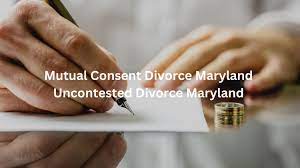Introduction
Divorce is a challenging and often emotionally charged process, but in Maryland, couples who are in mutual agreement to end their marriage can pursue a streamlined path known as mutual consent divorce. Understanding the essential information for filing a mutual consent divorce Maryland is crucial for couples seeking an amicable and efficient resolution to their marital dissolution. This article provides an overview of the key steps and considerations involved in filing for a mutual consent divorce in the state.
- Eligibility Requirements:
- Before considering a mutual consent divorce, it's essential to ensure that you meet the eligibility requirements set by Maryland law. Both spouses must:
- Have no minor children in common.
- Have a written and fully executed settlement agreement covering alimony, property, and any other relevant issues.
- Neither party should file a pleading to set aside the settlement agreement.
- Settlement Agreement:
- A crucial component of a mutual consent divorce is the comprehensive settlement agreement. This document outlines the terms and conditions agreed upon by both spouses regarding alimony, division of marital property and debts, and any other relevant issues. It is advisable to consult with an attorney to draft a clear and legally enforceable settlement agreement that protects the interests of both parties.
- Filing the Complaint:
- The next step involves filing a Complaint for Absolute Divorce with the circuit court in the jurisdiction where either spouse resides. The complaint should include the grounds for divorce, which, in the case of mutual consent divorce, is the mutual agreement of both parties to end the marriage. Along with the complaint, the settlement agreement and other required documents must be submitted to the court.

- Waiver of the Waiting Period:
- Maryland law requires a waiting period before a divorce is finalized, typically one year for most grounds of divorce. However, in the case of a mutual consent divorce, this waiting period can be waived. Both spouses must file a joint request to waive the waiting period, indicating their mutual agreement to proceed with the divorce without the statutory waiting period.
- Final Hearing:
- After the waiting period is waived, a final hearing is scheduled. At the hearing, both spouses must appear before the court to affirm their mutual consent to the divorce and confirm that the settlement agreement is fair and equitable. If the court finds the agreement to be valid and in compliance with the law, the divorce will be granted.
- Legal Representation:
- While mutual consent divorce is designed to be a more straightforward process, seeking legal representation is still advisable. An experienced family law attorney can provide guidance on the preparation of the settlement agreement, ensure all necessary documents are in order, and navigate any potential legal complexities that may arise during the divorce process.
- Financial Disclosures:
- Both spouses are required to make full financial disclosures during the divorce process. This includes providing information on income, assets, debts, and expenses. Accurate financial disclosures are crucial for a fair and equitable distribution of marital property and determination of any alimony obligations.
- Review of Settlement Agreement:
- Before filing the complaint, both spouses should carefully review the settlement agreement with their respective attorneys. This ensures that all terms are clearly understood, fair, and in accordance with Maryland law. The settlement agreement becomes a legally binding contract upon approval by the court.
- Post-Divorce Considerations:
- Once the divorce is finalized, it's important to address post-divorce considerations, such as updating legal documents, including wills, beneficiary designations, and other financial accounts. Reviewing and updating these documents helps ensure that they reflect the changed marital status and the agreed-upon terms of the divorce.
Conclusion
A mutual consent divorce in Maryland offers couples a more efficient and amicable way to end their marriage when both parties are in agreement on key issues. By understanding the eligibility requirements, the importance of a comprehensive settlement agreement, and the procedural steps involved, couples can navigate the process more smoothly. Seeking legal guidance is crucial to ensure that all legal requirements are met, and the divorce is conducted in compliance with Maryland family law. While divorce is undoubtedly a challenging life event, a mutual consent divorce provides a path toward resolution that is respectful of the parties involved and aims for a fair and equitable outcome.

No comments yet